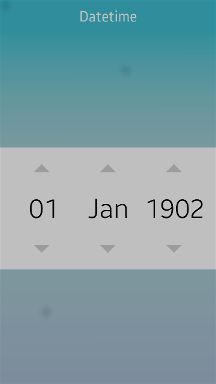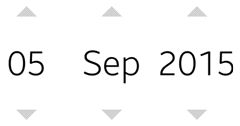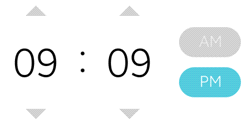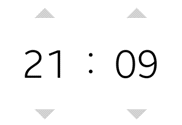Datetime
The datetime UI component displays date and time values. For more information, see the Datetime API.
This feature is supported in mobile applications only.
Basic Usage
To use a datetime component in your application:
-
Add a datetime component with the
elm_datetime_add()function:Evas_Object *datetime; datetime = elm_datetime_add(parent); -
Set a style and format. The datetime format is a combination of LIBC standard characters, such as “%d %b %Y %I : %M %M”. For more information on the format characters, see the Datetime API.
-
Set a style to the datetime component with the
elm_object_style_set()function. If you use the default style, you can skip this step.elm_object_style_set(datetime, "date_layout"); -
Set a format using the
elm_datetime_format_set()function:elm_datetime_format_set(datetime, "%d%b%Y");
-
Set datetime component options.
-
Register the callback functions.
The following example shows how to define and register a callback for the
changedsignal:evas_object_smart_callback_add(datetime, "changed", changed_cb, data); void changed_cb(void *data, Evas_Object *obj, void *event_info) { dlog_print(DLOG_INFO, LOG_TAG, "Datetime value changed\n"); }
The following example shows a simple use case of the datetime component.
Example: Datetime use case

Evas_Object *win;
Evas_Object *conf;
Evas_Object *nf;
Evas_Object *box;
Evas_Object *datetime;
time_t local_time;
struct tm *time_info;
/* Starting right after the basic EFL UI layout code */
/* (win - conformant - naviframe) */
/* Add a box to contain a datetime and push the box into the naviframe */
box = elm_box_add(nf);
evas_object_show(box);
elm_naviframe_item_push(nf, "Datetime", NULL, NULL, box, NULL);
/* Add a datetime and set a style */
datetime = elm_datetime_add(box);
evas_object_size_hint_align_set(datetime, EVAS_HINT_FILL, EVAS_HINT_FILL);
elm_object_style_set(datetime, "date_layout");
/* Set a format for datetime */
elm_datetime_format_set(datetime, "%d/%b/%Y");
/* Get a current local time to set as datetime value */
time(NULL);
time_info = localtime(&local_time);
elm_datetime_value_set(datetime, time_info);
evas_object_show(datetime);
elm_box_pack_end(box, datetime);
Options
You can set value ranges for the datetime component:
-
Set minimum and maximum values.
The datetime component provides a way to decide a range of the value.
Keep in mind the following ranges when you set up the time structure:
Year: Years since 1900. Negative value represents a year below 1900 (year value -30 represents 1870). Year default range is from 70 to 137.Month: Default value range is from 0 to 11.Date: Default value range is from 1 to 31 according to the month value.Hour: Default value is in 24-hour format (0~23).Minute: Default value range is from 0 to 59.
To set the maximum time for the datetime component:
elm_datetime_value_max_set(datetime, tm);To set the minimum time for the datetime component:
elm_datetime_value_min_set(datetime, tm); -
Set limits to the field values.
The datetime component has the following fields:
ELM_DATETIME_YEAR: Indicates the year field.ELM_DATETIME_MONTH: Indicates the month field.ELM_DATETIME_DATE: Indicates the date field.ELM_DATETIME_HOUR: Indicates the hour field.ELM_DATETIME_MINUTE: Indicates the minute field.ELM_DATETIME_AMPM: Indicates the AM/PM field.
To set a value range for a specific field:
elm_datetime_field_limit_set(datetime, ELM_DATETIME_DATE, 10, 20);
Styles
The following table lists the available component styles.
Table: Datetime styles
| Style | Sample |
|---|---|
defaultdate_layout |
 |
time_layout |
 |
time_layout_24hr |
 |
Note
Pay attention to the following UX issue since Tizen 2.3:
The
time_layoutandtime_layout_24hrstyles need a full-length format that includes the year, month, day, hour, minute, and AM/PM. Each style shows specific fields from the format, limited by the UX concept:
date_layout(default): Year, month, daytime_layout: Hour, minute, AM/PM buttontime_layout_24hr: Hour, minuteIf you call the
elm_datetime_field_visible_set()function for a field that is not supported in the current style, the function does not work.
Callbacks
You can register callback functions connected to the following signals for a datetime object.
Table: Datetime callback signals
| Signal | Description | event_info |
|---|---|---|
changed |
The datetime field values change. | NULL |
language,changed |
The system locale changes. | NULL |
Note
The signal list in the API reference can be more extensive, but only the above signals are actually supported in Tizen.
Note
Except as noted, this content is licensed under LGPLv2.1+.
Related Information
- Dependencies
- Tizen 2.4 and Higher for Mobile